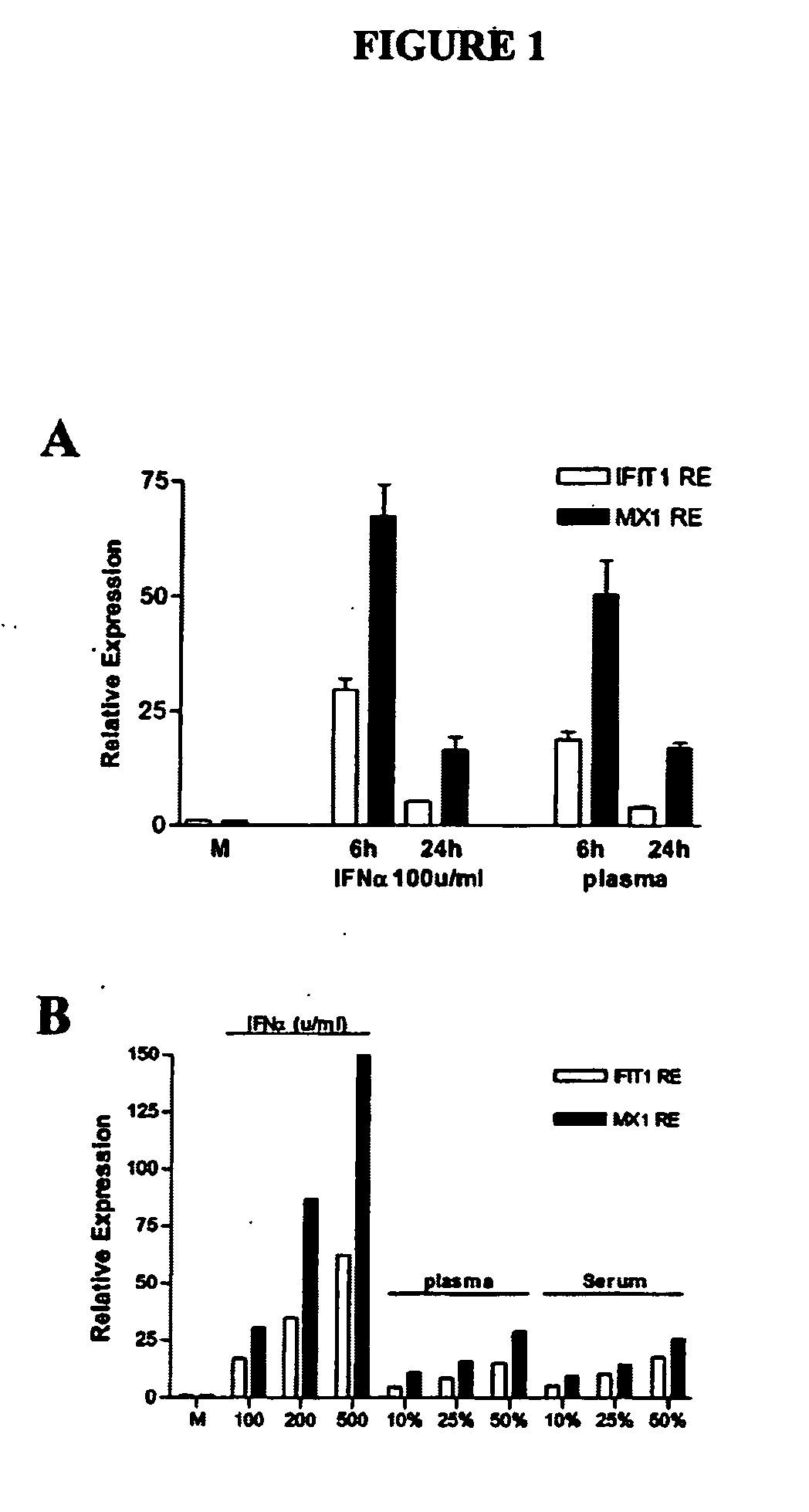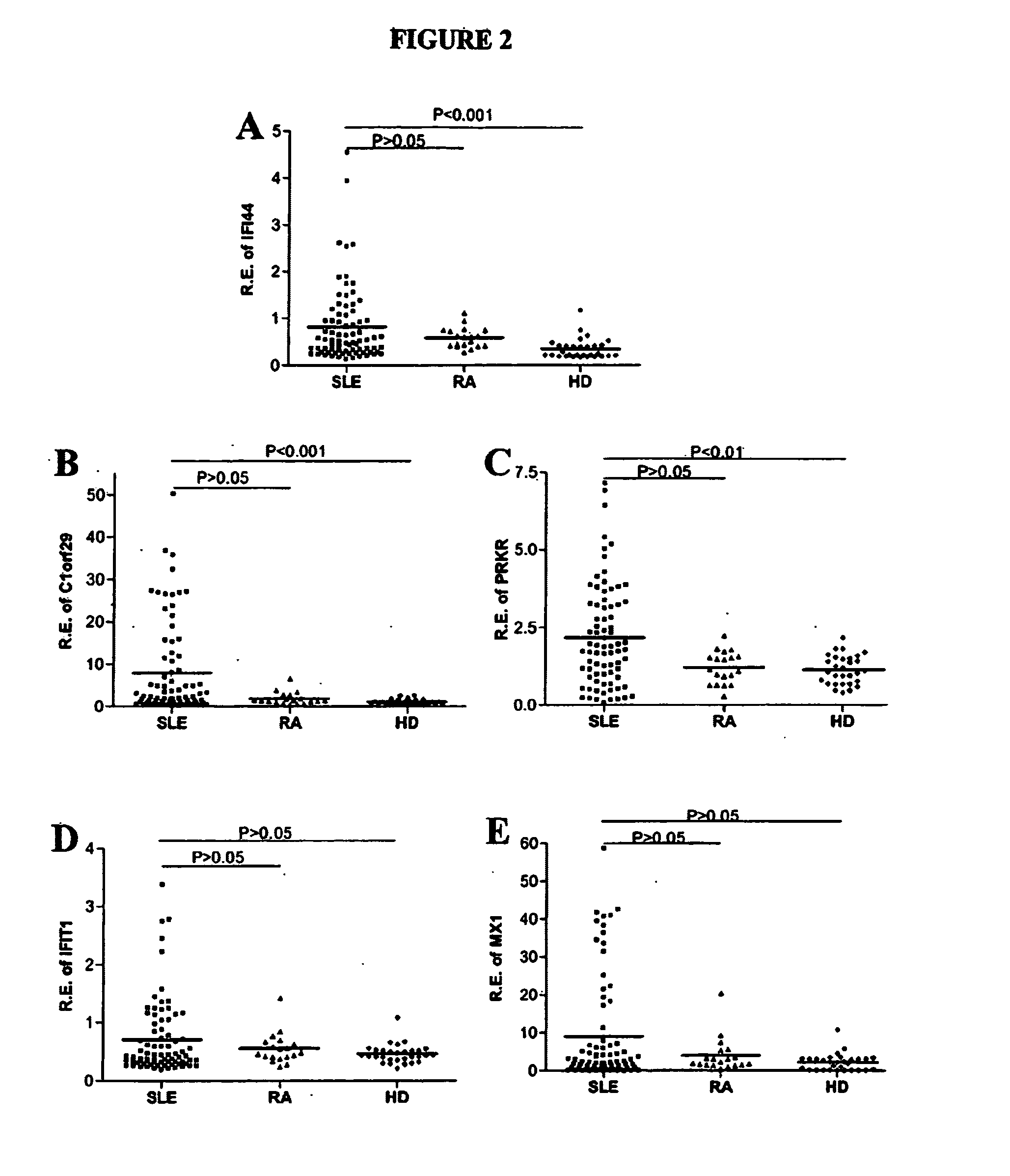Interferon assay
a reporter cell and assay technology, applied in the field of methods and reporter cell assays, can solve the problems of difficult diagnosis of diseases, no single laboratory test that can definitively detect lupus, and serious and life-threatening diseases
- Summary
- Abstract
- Description
- Claims
- Application Information
AI Technical Summary
Benefits of technology
Problems solved by technology
Method used
Image
Examples
example 1
[0097] Induction of IFIG in an in vitro WISH cell system by recombinant human interferon: time course and dose response. To develop an in vitro assay for quantification of IFIG-inducing activity in patient plasma or serum, WISH cell line cells, previously demonstrated to be IFN-responsive (31), were cultured with rhIFNα, rhIFNγ or SLE plasma. Expression of five genes, interferon-induced protein with tetratricopeptide repeats 1 (IFIT1, SEQ ID NO:15,), interferon-induced protein 44 (IFI44, SEQ ID NO:16, deduced amino acid sequence SEQ ID NO:17), protein kinase, interferon-inducible double stranded RNA dependent (PRKR, SEQ ID NO:18, deduced amino acid sequence SEQ ID NO:19) also known as eukaryotic translation initiation factor 2-alpha kinase 2 (EIF2AK2)), C1orf29 (SEQ ID NO:20, deduced amino acid sequence SEQ ID NO:21) and myxovirus (influenza virus) resistance 1 (MX1, SEQ ID NO:22, deduced amino acid sequence SEQ ID NO:23) was measured in cultured WISH cells. These five genes were pr...
example 2
[0101] Correlation of lupus plasma activity with expression of IFIG in SLE PBMC. To assess the level of IFIG-inducing activity in plasmas from a diverse population of SLE patients, as well as in plasmas from disease controls with RA and from healthy subjects, WISH cells were cultured with medium or with plasma from seventy-three SLE patients, nineteen RA patients and thirty healthy donors and IFIG expression was measured by real-time PCR. Five IFNα-inducible genes and one IFNγ-inducible gene were quantified. Plasma samples from patients with SLE (n=73) or RA (n=19), or from healthy donors (n=30), were incubated with WISH cells at a 50% volume / volume concentration for 20 hrs. WISH cells were then lysed and used for RNA isolation, reverse transcription, and amplification by quantitative real-time PCR. Relative expression of five IFNα-induced genes is shown. Mean values for each group are indicated by the horizontal line shown in FIG. 2. P values for differences between SLE patients an...
example 3
[0103] Correlation of IFNα-inducible genes in WISH cells cultured with SLE plasma with the level of mRNA encoded by IFNα-inducible genes in PBMC cells from patients. The expression of each of these five IFNα-inducible genes in WISH cells cultured with SLE plasma was correlated with the level of mRNA encoded by IFNα-inducible genes in the PBMC of those same patients collected on the same day, as expressed as an IFNα score (FIG. 3). Relative expression of 5 IFNα-induced genes in WISH cells cultured with 50% lupus plasma was plotted against the IFNα score, previously assayed based on real-time PCR analysis of patient PBMC cells. The IFNαscore was calculated based upon previous real-time PCR analysis of expression of three IFNα-inducible genes (IFIT1, IFI44, PRKR) in patient PBMC. The expression of IFIT1, IF44, and PRKR in patient PBMC was described in detail by Kirou et al. 2005 (11). The Spearman rho(r) and p correlation values are shown. The p value for each of the five IFNα-inducibl...
PUM
| Property | Measurement | Unit |
|---|---|---|
| temperatures | aaaaa | aaaaa |
| temperatures | aaaaa | aaaaa |
| temperatures | aaaaa | aaaaa |
Abstract
Description
Claims
Application Information
 Login to View More
Login to View More - R&D
- Intellectual Property
- Life Sciences
- Materials
- Tech Scout
- Unparalleled Data Quality
- Higher Quality Content
- 60% Fewer Hallucinations
Browse by: Latest US Patents, China's latest patents, Technical Efficacy Thesaurus, Application Domain, Technology Topic, Popular Technical Reports.
© 2025 PatSnap. All rights reserved.Legal|Privacy policy|Modern Slavery Act Transparency Statement|Sitemap|About US| Contact US: help@patsnap.com



